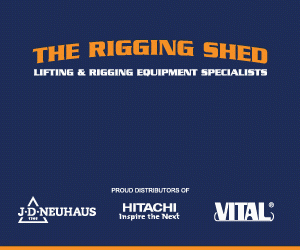)
Supporting Australia’s defence boom
Government investment in the defence sector is creating a substantial domestic end-user market that will increasingly need to call on the support of Australia’s lifting industry. To ensure that the high levels of quality and safety demanded in defence are met, it is crucial that procurement teams in the sector look to LEEA members, says Justin Boehm, Member Engagement Manager for Australia at the Lifting Equipment Engineers Association (LEEA).
Over the next decade the Australian government has pledged to invest an historic $200 billion to modernise the country’s defence capability. In addition to aircraft and artillery this spend will include approximately $90 billion on the continuous naval shipbuilding programme. This will fund the construction of over 50 naval ships and submarines in Australia in what is said to be the largest regeneration of the Navy since the Second World War. Furthermore, it will contribute to the development of a strong Australian naval shipbuilding industry. Investment also continues in upgrading and expanding the country’s defence estate, comprising hundreds of bases, facilities and other sites right across Australia.
There are already some 3000 businesses trading in the Australian defence sector and the government wants local industry to be involved heavily in production and support. Through its Local Industry Capability plans for major defence infrastructure projects, the government hopes to ensure local industry has the best opportunity to reap the benefit of the investment in defence capability.
Australia growing its defence industrial base over the coming decade and turning into an exporter of military equipment, rather than just an importer, is certainly positive news for the lifting industry, which plays an important role across the defence sector. We can expect lifting equipment to proliferate through lean manufacturing and industrial engineering principles. For example, installing multiple cranes, will give companies greater flexibility and volume capacity required to win new projects. In addition to the manufacture of defence equipment, there will also be more lifting operations involving that equipment on military bases – involving wire rope, personal fall protection equipment, slings, hoists, cranes and other equipment – much of which will need to be of bespoke design.
As with any sector, reliability leading to minimised downtime is fundamental, while safety in all tasks will, of course, be paramount. It will be critically important for companies working on, or bidding for, contracts in the defence sector to ensure they use all appropriate measures to reduce risk of accidents, as well as to minimise inefficiency.
Procurement teams know that testing and inspections of lifting equipment need to happen. Having had discussions with defence firms, it has been disappointing to hear they do not appear to be using LEEA members as frequently as one would hope.
Yet one of the best ways for Australia’s growing defence industry operations to mitigate the risk of an inspection by health and safety authorities is to look out for the LEEA logo when procuring lifting equipment or supporting services. This shows that the service provider is a member of the Lifting Equipment Engineers Association – which is established across the globe as the leading representative body for all those involved in the lifting industry worldwide. As a member, the provider has undergone a rigorous auditing process to uphold LEEA’s ‘gold standard’ and provide customers with the assurance of excellence. LEEA members adopt a Quality Management System, which combined with training and documentation procedures, will provide companies operating in the defence sector with the necessary confidence in quality and safety in lifting operations.
It is crucial that companies working in the burgeoning defence end user market are made aware of this and encouraged to use LEEA members. So I am particularly keen to work closely with our members in the promotion of excellence and to increase their influence to help build an increasingly successful Australian defence industry.









